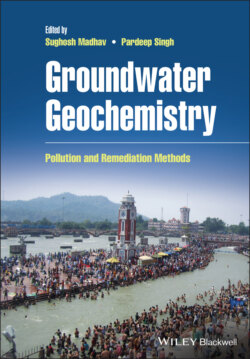Читать книгу Groundwater Geochemistry - Группа авторов - Страница 126
4.6.7 Adsorption Method
ОглавлениеThe adsorption method is considered to be the best method in comparison to the other methods discussed here because of their limitations like low efficiency, high cost, etc. The key advantages of the adsorption method are low cost, sludge free, high efficiency, easy recovery of metals and possibility to reuse the adsorbent (Sharma et al. 2015; Agrawal et al. 2018; Agrawal et al. 2019). Generally, adsorption is a mass transfer process, in which a substance transfers from the liquid phase to the solid phase and bounds by physical and chemical interactions (Babel and Kurniawan 2003). The adsorption process can be accomplished either by electrostatic interaction (ionic interaction between positively charged metal ions and negatively charged matrices) or by chelation (donation of the lone‐pair electrons of the matrices to metal ions to form coordinate bonds). More effective adsorption of toxic metals depends on the properties of the heavy metal solutions such as temperature, pH of the solution, and specification of heavy metal; for example, at neutral or lower pH, As(V) shows better adsorption efficiency than As(III). The use of activated carbon (Li et al. 2018; Hashim et al. 2019), activated alumina (Szatyłowicz and Skoczko 2018), carbon nanotubes (CNTs) (Zhu et al. 2019), porous carbon (Agrawal et al. 2019), graphene (Fausey et al. 2019; Dai et al. 2020), and ferric oxide particles (Majumder et al. 2019) have generated much interest, and novel metal modified adsorbents have demonstrated superior performance towards heavy metal decontamination. Carbonaceous materials have comparatively good efficiency of adsorption, large surface area, tuneable pores, high porosity, and good sorption sites for adsorbate, and are easy to synthesize and cost effective.
